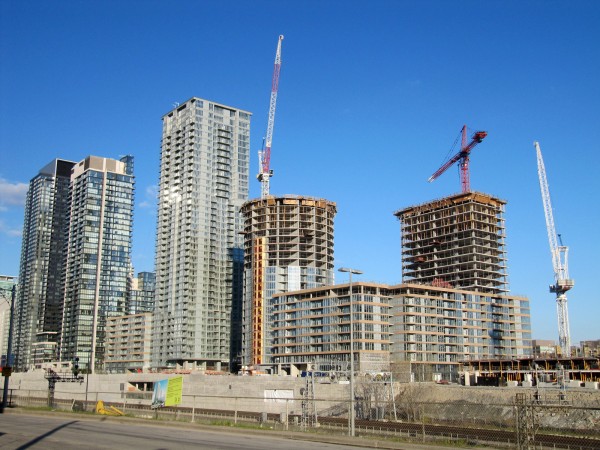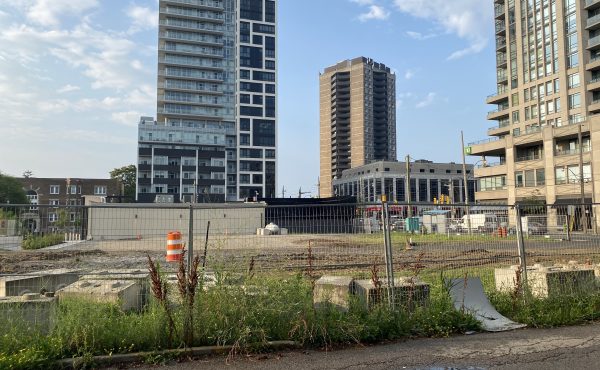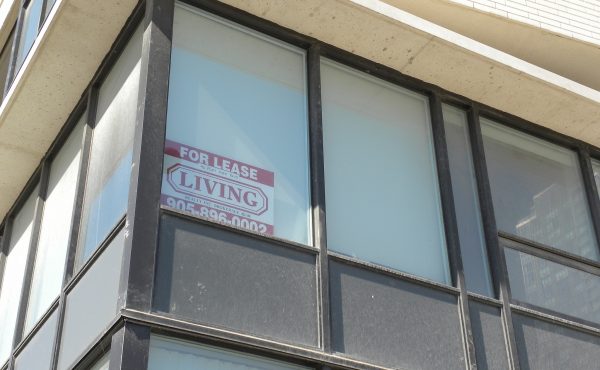
Until the Canada Mortgage and Housing Corp. (CMHC) released a new report showing that a shortage of supply wasn’t, in fact, the culprit in the speculative chaos that has seized the GTA’s housing market, various vested interests (Tories, developers, realtors, etc.) were hammering away at the idea that the province needs to unlock more developable land on the region’s exurban fringes to bring down prices.
The CMHC’s timely piece of market intelligence clears the way for the provincial Liberals to impose some kind of demand-side solution meant to take the energy out of a bubble that, as Bank of Canada governor Stephen Poloz warned last week, could create a national economic mess if/when it pops. Given all the signals coming out of Queen’s Park, finance minister Charles Sousa’s April 27 budget will contain some kind of anti-speculation tax, likely one aimed at foreign buyers.
But from where I sit, the supply-side/demand-side dualism in this increasingly frantic search for solutions looks like a false dichotomy. The Liberals shouldn’t interpret those new housing start reports as evidence that their GTA land-use and transportation planning policies are in good shape, because they’re not.
Indeed, if Kathleen Wynne & Co. were thinking about something other than the 2018 election, they’d be making long-overdue planning and funding reforms that could head off the next speculative wave, which will invariably begin once the market adjusts to whichever measure they drop into the budget.
As every real estate agent knows, the price spikes have been greatly fueled by the hobbled state of transit development in the GTA, with the most extreme inflation occurring — surprise! surprise! — in the vicinity of subway stops and within the commuter sheds of GO stations.
Yet for reasons that surpass understanding, the Liberals have refused to thoroughly integrate the two gigantic GTA planning exercises — one for the Greater Golden Horseshoe growth plan, the other for Metrolinx’s Big Move (a.k.a. the Regional Transportation Plan) — that have been inching glacially through their respective consultation processes over the past year.
The result is that the province is ignoring opportunities to use those much-touted transit investments to really push GTA municipalities to intensify around new subway, LRT and SmartTrack stops, or in the vicinity of the GO stations now being converted to all-day/two-way 15-minute service (regional express rail).
Those kinds of policies, widely in use in Europe and other jurisdictions that actually practice transit-oriented development, would go a long way towards mitigating the two extremes Toronto’s residential market: over-development in a few key zones (Kings, Yonge/Eglinton) and insane price wars on single-family homes in most other places.
It’s not like any of these insights are state secrets; this is Planning 101.
For several years, Metrolinx has sought to work with regional municipalities on planning studies to intensify around the so-called “mobility hubs” – 51 key GO and subway stations across the GTA that are deemed to have the potential to attract and support far more commercial, office and residential development than they currently have. But Metrolinx, of course, isn’t a regional planning authority, and officials there say that reaction to their friendly overtures from GTA municipalities has been hit and miss. Some are eager; others (including the City of Toronto), not so much.
As an ostensibly independent agency of the Ontario Ministry of Transportation, it’s perhaps not surprising that Metrolinx has been told to stay in its lane. But the province’s disinclination to get the maximum bang for the tens of billions it will spend in the next twenty years on transit infrastructure is not only a vast lost opportunity; the failure to actively spur development around these hubs fuels the vicious circle that is driving residential speculation in the GTA. (The notable exception is the highly strategic corridor planning that is accompanying the construction of the Eglinton Crosstown LRT.)
In a budget that will have lots to say about housing, Sousa has an excellent opportunity to break this absurd bureaucratic logjam between MTO and the ministry of municipal affairs and housing, the two agencies tasked with these planning exercises. He could, for example, move to create clear financial carrots and sticks – e.g., infrastructure grants, or punitive conditions on other sorts of municipal funding – as a means of compelling GTA communities to make the most of the intensification opportunities created by RER in particular. (The 40% intensification targets in the Places to Grow Act aren’t explicitly inked to transit investment, which means new development may be very car dependent.)
Such a move wouldn’t be about adding to the housing supply glut posited by some analysts; it’s about decanting the extreme concentrations of capital that have produced bidding wars, on the one hand, and over-development, on the other.
Instead, Metrolinx’ board, having been told in not so many words, to keep its institutional nose out of local land-use planning, is preparing to spend $1.4 billion to add 24,000 new parking spaces (as well as other access amenities) at its GO stations to accommodate all the new riders projected for the RER era. (That investment will bring the total amount of vehicle parking on GO lots to about 95,000 spaces.)
The agency’s stated goal is to significantly reduce the proportion of so-called “drive-and-park” users of said stations, from the current 62% range to the mid-30s. But it’s difficult to see how that shift will actually happen if the province doesn’t take concurrent steps to push municipalities to meaningfully intensify around all those stations, as Greater Vancouver is doing near its SkyTrain hubs.
The Liberals’ standard defense (besides staunchly protecting the sacrosanct convenience of GO commuters) is that they don’t want to be overly prescriptive with municipalities, which, after all, have their own elected officials and constituencies.
However, we all know the real reason, and the Scarborough subway debacle is but one illustration. If common sense land-use planning policies, rather than self-interested partisan politics, drove transit investment, Queen’s Park would have pulled the plug long ago, opting instead to deploy those billions in ways that produce multiple benefits (intensification along arterials, employment, housing equity).
I’m not under any delusion that Wynne’s Liberals, after years of cynically mismanaging transit spending, will see the light at this late hour. Instead, the government will roll out a few showy tax measures, blame the Bank of Canada and pray that all those lurid over-asking anecdotes will subside by next spring. And for the umpteenth time, they’ll have missed yet another opportunity to do the right thing, as opposed to the expedient thing.





11 comments
One thing Metrolinx could do all by itself is start charging for parking at GO stations. That would at least help nudge transit- and walking-oriented development around stations. It could also help fund building more multi-level parking to clear away some of the other parking lot space for transit-oriented development beside the stations.
Another idea that Metronlinx could do by itself is further improve pedestrian and cycling access to GO stations, helping to make potential nearby developments more appealing.
Can you provide evidence for what “every real estate agent knows” is Infact true?
Even the Eglinton plan isn’t particularly ambitious. Sure, Eglinton itself will see some development, maybe. But walk a lot or two up every street it crosses and you’ll be right back in a “stable neighbourhood” where the policy is all backwards, and its easier to remove housing than to add it. Embarrassing that areas within walking and cycling distance of LRT will be locked out of growth.
Good piece, John.
I’ve often wondered what it will take to finally get that integration of development, transportation and infrastructure that we need to bring truly smart, sustainable growth to the GTHA.
It’s doubly interesting that Metrolinx is being told to “stay in their lane” because in 2013, when Metrolinx introduced their preferred investment strategy, Robert Prichard also mentioned a redesign of the Metrolinx Board to add more regional political representation. And last year, Metrolinx hosted the first joint TTC-Metrolinx board meeting, which was also attended by political leaders from Halton and York Regions.
One would think that better cooperation between Metrolinx and regional and local governments would be a prerequisite for the transformational projects we have been promised.
Definitely move on upzoning around transit. I would even suggest upzoning along main streets. How many main streets outside of Toronto’s downtown core are lined with single family homes? There are bus lines on all of these, so some sort of upzoning to allow at least multi-storey flats could boost transit usage, which is subsidized outside the core while allowing people to live outside of the core. Of course, the density inside the side streets is still way too low, but it’s a start and would not be nearly as controversial as the mega-buildings that developers build today.
We really do need new and effective transit corridors, and given how messed up everything is, what can we do on-surface and quickly in a silver buckshot approach vs. a silver bullSSEt, as it were. And to get faster-done transit, it means thinking of political will to establish surface Rights-of-Way using the Brazilian city of Curitiba as a concept. Indeed, while not every road can handle RoWs, what new corridors are possible off-road? The Gatineau Hydro corridor could well be a significant part of a Scarborough solution that could be in place relatively quickly, and if we pushed it further, and had a bit of a budget for bridging and the heavier construction works that are preferred for many transit projects, we could link to Thorncliffe Park with its density and high transit usage. Further works could either go to the linkage to the St. Clair Ave. via tunnelling (with as much sensitivity to both good citizens and the environment as possible) or to one of three ways in to the core in the Don Valley ie. DVP; the rail spur from Brickworks south, or Bayview Ave. If we had more sub-regional and express transit vs. milk runs, and more connectivity, we might have an easing of pressures, as Mr. Lorinc notes.
I’m having trouble finding the CMHC report you speak of, “showing that a shortage of supply wasn’t, in fact, the culprit in the speculative chaos”. The National Post article was not clear. Could you provide a link to it?
I’m with you Hamish. Surface bus-only lanes are such a good place to start. They can provide transit for the next decade or two, allowing people to move about quickly in the years before more subways, surface rails, autonomous vehicles, or semi-autonomous vehicles are in place.
I just don’t understand why Toronto’s public transport infrastructures (subways, …) are so far behind Montreal’s. Seems like Montreal always had more vision than Toronto.
Haruki — There is no metric or evidence that supports that Montreal’s transit system is better than Toronto’s. Toronto has more bus routes, more subway stations, greater ridership per capita, more transit options & technologies, etc. If you can point me to somewhere that argues this differently, there is nothing to your comment that makes sense.
In fact, toronto’s system is probably the 2nd or 3rd best in North America. We might not like it much, but travelling and taking transit in any other big city in Canada and the US shows how much more fortunate we are. Now imagine if the TTC and Metrolinx were actually capable of fixing their long standing issues how great our transit could be?
further to rick’s comment, where is the analysis showing lack of supply isn’t a problem in the market. What the data shows is that construction have jumped and that condo sales are up. It further says that the jump in starts for high rise stems back to a big jump in sales back in 15/16. The number of units coming to market since then has gone down so while sales are doing well they’re further buying down inventory.
So, to read into the stats a little more. The construction starts data doesn’t do anything for people who are looking for a place to live today for the obvious reason that a unit under construction can’t be lived in. So, what about people who are looking to buy something today. Well, the market is launching fewer units into the market, so the construction starts data doesn’t do much to help that either.
Further, high-rise construction starts are notoriously ‘lumpy’ because of the size of the projects coming to market now, so whether this above average rate of starts is sustainable is very much in question.
What am i misunderstanding here?